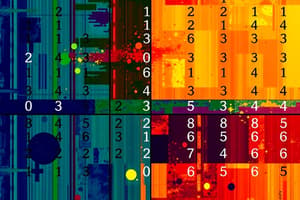Podcast
Questions and Answers
What is the result of adding two matrices?
What is the result of adding two matrices?
- Only possible if the matrices are square.
- The identity matrix.
- A matrix where each corresponding element is summed. (correct)
- A matrix with doubled dimensions.
Which type of matrix has the same number of rows and columns?
Which type of matrix has the same number of rows and columns?
- Row Matrix
- Square Matrix (correct)
- Zero Matrix
- Column Matrix
Under what condition does a matrix have an inverse?
Under what condition does a matrix have an inverse?
- It has to be an identity matrix.
- It must be a square matrix with a non-zero determinant. (correct)
- It must be a row matrix.
- It must have at least one row of zeros.
What happens to the determinant when two rows of a matrix are swapped?
What happens to the determinant when two rows of a matrix are swapped?
Which operation on matrices is not valid unless the matrices have compatible dimensions?
Which operation on matrices is not valid unless the matrices have compatible dimensions?
What is the determinant of a 2x2 matrix defined as [[2, 3], [4, 5]]?
What is the determinant of a 2x2 matrix defined as [[2, 3], [4, 5]]?
What role do determinants play in geometry?
What role do determinants play in geometry?
What is the primary use of the identity matrix?
What is the primary use of the identity matrix?
Flashcards are hidden until you start studying
Study Notes
Matrices
-
Definition: A matrix is a rectangular array of numbers arranged in rows and columns.
-
Types of Matrices:
- Row Matrix: A matrix with only one row.
- Column Matrix: A matrix with only one column.
- Square Matrix: A matrix with the same number of rows and columns.
- Zero Matrix: A matrix where all elements are zero.
- Identity Matrix: A square matrix with 1s on the diagonal and 0s elsewhere.
-
Matrix Operations:
- Addition: Matrices can be added if they have the same dimensions.
- Subtraction: Similar to addition; matrices must have the same dimensions.
- Scalar Multiplication: Multiplying every element in the matrix by a scalar (constant).
- Matrix Multiplication: The product of an m×n matrix and an n×p matrix results in an m×p matrix. The element at position (i, j) is the dot product of the i-th row of the first matrix and the j-th column of the second.
-
Transpose of a Matrix: The matrix obtained by flipping a matrix over its diagonal, switching the row and column indices.
-
Inverse of a Matrix: A matrix A has an inverse, denoted A⁻¹, if A * A⁻¹ = I (Identity Matrix). Only square matrices can have inverses, and they must be non-singular (determinant ≠ 0).
Determinants
-
Definition: A determinant is a scalar value that is a function of a square matrix, providing important properties of the matrix.
-
Notation: The determinant of a matrix A is denoted as det(A) or |A|.
-
Properties:
- Determinant of a 1x1 matrix: |a| = a.
- Determinant of a 2x2 matrix: For matrix A = [[a, b], [c, d]], |A| = ad - bc.
- If two rows (or columns) are identical, the determinant is 0.
- If a row (or column) is a scalar multiple of another, the determinant is also 0.
- Swapping two rows (or columns) changes the sign of the determinant.
-
Calculation Methods:
- Expansion by Minors: Can be used for larger matrices by breaking them down into smaller matrices.
- Row Reduction: Transform the matrix to an upper triangular form and multiply the diagonal elements, considering row swaps.
-
Applications:
- Determinants help in solving linear equations (Cramer’s rule).
- Useful in finding the area or volume in geometry.
- Determine whether a matrix is invertible (non-zero determinant indicates invertibility).
Matrices
- A matrix is a rectangular array of numbers organized in rows and columns.
- Types of Matrices:
- Row Matrix: Contains only one row of elements.
- Column Matrix: Consists of a single column of elements.
- Square Matrix: Has an equal number of rows and columns.
- Zero Matrix: All elements are zero.
- Identity Matrix: Square matrix with 1s on the diagonal and 0s elsewhere.
- Matrix Operations:
- Addition: Possible for matrices of the same dimensions.
- Subtraction: Similar to addition; matrices must match in size.
- Scalar Multiplication: Every element in the matrix is multiplied by a constant.
- Matrix Multiplication: The result of an m×n matrix multiplied by an n×p matrix is an m×p matrix. The element at position (i, j) is the dot product of the i-th row of the first matrix and the j-th column of the second.
- Transpose of a Matrix: Flips the matrix over its diagonal, switching rows with columns.
- Inverse of a Matrix: A square matrix A has an inverse (denoted A⁻¹) if multiplying A by A⁻¹ yields the identity matrix I. Inverses exist only for non-singular matrices (det(A) ≠ 0).
Determinants
- A determinant is a scalar value derived from a square matrix that reveals key properties of that matrix.
- Notation for determinants includes det(A) or |A|.
- Properties:
- The determinant of a 1x1 matrix is simply the value of that element.
- For a 2x2 matrix A = [[a, b], [c, d]], the determinant is calculated as |A| = ad - bc.
- If two rows or columns are identical, the determinant equals 0.
- A row or column being a scalar multiple of another also results in a determinant of 0.
- Swapping two rows or columns changes the sign of the determinant.
- Calculation Methods:
- Expansion by Minors: Breaks larger matrices into smaller parts for calculation.
- Row Reduction: Transform the matrix into upper triangular form and multiply the diagonal elements, accounting for row swaps.
- Applications:
- Determinants are crucial for solving linear equations using Cramer’s rule.
- They assist in calculating areas and volumes in geometric contexts.
- A non-zero determinant indicates that a matrix is invertible.
Studying That Suits You
Use AI to generate personalized quizzes and flashcards to suit your learning preferences.




